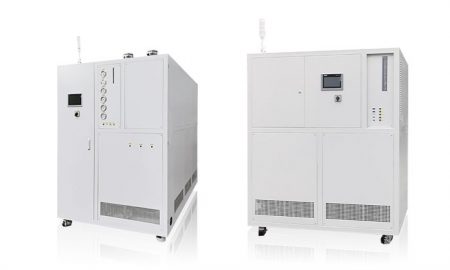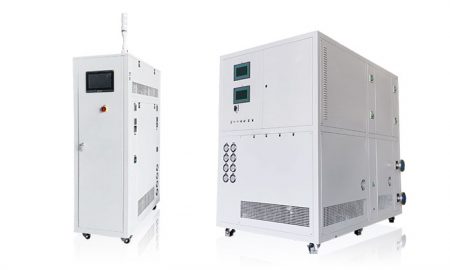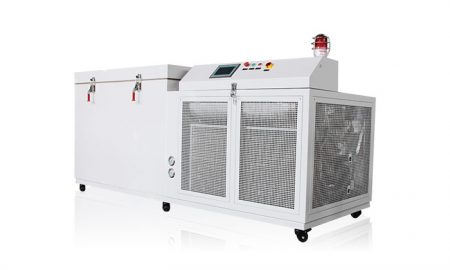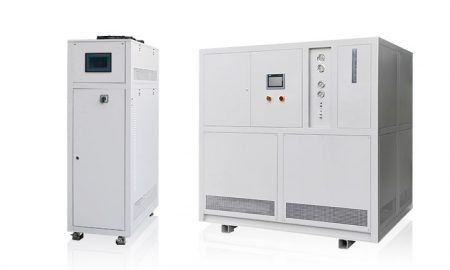Precautions for the Selection of Air Cooled Screw Chillers
The screw chiller is named as screw chiller because its key component compressor adopts screw type. According to the different heat dissipation methods, it can be divided into two types: water-cooled screw refrigerators and air-cooled screw refrigerators.
The refrigerating capacity of the screw chiller ranges from 100kw/h to 860kw/h, and the power of the screw compressor can range from 38KW-178kw. It can be widely used in all walks of life with particularly huge cooling capacity. So when we choose a screw chiller, what aspects should we start from?
1. The selection of the screw chiller should be considered according to the cooling load and where it is to be used. For the refrigeration system with low-load operation for a long time, it is suitable to choose a multi-head screw compressor unit, which is convenient for adjustment and energy saving, which is what we often call a double-head screw chiller or a three-stage screw chiller. With the change of load, the chiller can automatically determine the capacity of the compressor to be turned on, so as to ensure that the compressor that is turned on is in a better working state, thereby effectively saving electric energy.
2. When choosing a screw chiller, give priority to units with higher performance coefficients. According to previous statistics, the normal operating time of chillers under load throughout the year accounts for less than 1/4 of the operating time. The operating time ratios of 75%, 50%, and 25% loads are roughly 2.3%, 41.5%, 46.1%, and 10.1%. Therefore, when choosing a chiller, priority should be given to the chiller model with a flatter efficiency curve.
At the same time, the adjustment range of the chiller load should be considered in the design and selection. The multi-head screw chiller has excellent partial load performance, and the screw chiller can be selected according to the actual situation of the factory.
3. When choosing a screw chiller, you should pay attention to the conditions of the nominal working condition. The actual cooling capacity of the chiller is related to the following two points:
a. The chilled water outlet temperature and return water temperature of the chiller, that is, the inlet and outlet water temperatures of the shell-and-tube evaporator;
b. The inlet water temperature, flow rate and fouling coefficient of the cooling circulating water of the chiller refer to the inlet and outlet water temperature of the condenser.
c. If you choose an air-cooled screw chiller, you must pay attention to the ambient temperature and humidity. These factors directly affect the efficiency and service life of the chiller.
d. If the screw chiller is used in special industries, chemical industry, medicine, aerospace, machinery, aviation, chemical fiber and other industries with special requirements, it is necessary to clarify the use place with the salesperson in advance. For example, the chemical industry may require electrical explosion-proof treatment, shell-and-tube type The evaporator needs anti-corrosion treatment, etc.
4. When choosing a screw chiller, you should pay attention to the normal working range of this type of screw chiller, mainly because the current limit of the motor is the current value of the shaft power under surface conditions.
5. When designing and selecting a screw chiller, it should be noted that under the actual working condition and flow rate, the outlet temperature of the chilled water should not exceed 15 °C, that is, the evaporation temperature should not be higher than the range of the screw unit, otherwise serious liquid backflow will occur. , causing a liquid shock. The outdoor dry bulb temperature of the air-cooled screw chiller should not exceed 43°C.
We are a professional manufacturer of temperature control equipment, supporting customized services, please consult us for details!
Temperature Control Range: -150°C to +50°C

Dynamic Temperature Control Systems
Temperature Control Range: -120°C to +350°C

Temperature Control Range: -40°C to +100°C

Temperature Control Range: -85°C to +250°C

Temperature Control Range: -150°C to -10°C
 LNEYA
LNEYA
 简体中文
简体中文


















































































